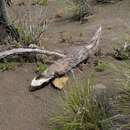en
names in breadcrumbs


This animal has not been extensively studied resulting in very little published information.
Perception Channels: tactile ; chemical
Although this species has no special status, it is reportedly rare in Chile (Nowak, 1999)
CITES: no special status
IUCN Red List of Threatened Species: data deficient
No adverse affects on humans have been reported.
This weasel has reportedly been kept by some ranchers as a working pet to destroy rats (Nowak, 1999).
Positive Impacts: controls pest population
Because the dietary habits of this animal are not known, it is difficult to speculate on the role it plays within its ecosystem. However, L. patagonicus likely plays some role in regulating small rodent populations.
The specific food habits of Patagonian weasels are little known, but the fact that this species has reduced molars and well-formed carnassials suggests that it is primarily carnivorous (Ewer, 1973). Patagonian weasels have been noted to enter burrows of Ctenomys and Microcavia in pursuit of prey.
Animal Foods: mammals
Primary Diet: carnivore (Eats terrestrial vertebrates)
Lyncodon patagonicus has a distribution within the Neotropical region. Its range is from the southern and western parts of Argentina into Chile (Redford and Eisenberg, 1992).
Biogeographic Regions: neotropical (Native )
There is not a lot known about the habitat of L. patagonicus. The little research there is on this species suggests that Patagonian weasels are found in Pampas habitats that have light-colored substrates excluding deserts (Gittleman, 1996).
Habitat Regions: temperate
Lifespan and longevity of this species are unknown.
The head and body length of Lyncodon patagonicus ranges from 300 to 350 mm, with the tail adding an additional 60 to 90 mm (Nowak, 1999). Patagonian weasels have a dental formula of 3/3, 1/1, 2/2, 1/1= 28 (Mares, 1989). They have very small ears that are covered by the surrounding fur. Generally, the the fur is whitish with some dark brown and black tones intermixed. From the top of the head to along its backside there is a distinguishable broad white or yellowish band of fur. Lyncodon patagonicus has short legs, a long body, and a short bushy tail (Redford and Eisenberg, 1992).
Average mass: 225 g.
Range length: 300 to 350 mm.
Other Physical Features: endothermic ; homoiothermic; bilateral symmetry
Predation on this species has not been reported.
The mating system and behavior of Patagonian weasles remains unknown at this time. However, most mustelids associate only briefly during the mating season. Males have territories that overlap with those of several females and they monitor their reproductive state through chemical cues.
The reproductive behavior of this species has not been characterized.
Key Reproductive Features: iteroparous ; gonochoric/gonochoristic/dioecious (sexes separate); sexual ; fertilization (Internal ); viviparous
Parental care in L. patagonicus is as unknown as the rest of the species' reproductive behavior. As in all mammals, the female nurses her young. Mustelids in general produce altricial young, which reside in a den or burrow until their eyes are open and they are able to walk. At this time, young weasels typically accompany their mother on foraging trips.
Parental Investment: altricial ; female parental care
The Patagonian weasel (Lyncodon patagonicus) is a small mustelid that is the only member of the genus Lyncodon.[2] Its geographic range is the Pampas of western Argentina and sections of Chile. An early mention of the animal is in the Journal of Syms Covington, who sailed with Charles Darwin on his epic voyage aboard HMS Beagle.
The Patagonian weasel has a head and body length of 300–350 mm (12–14 inches), with a tail that is 60–90 mm (2.4–3.5 inches). Its fur is whitish with black and dark brown tones mixed in. It has small ears, short legs and a bushy tail. The animal has not been thoroughly studied in the wild, and knowledge of its behavioral patterns is unsure. It reportedly has been kept as a working pet by local ranchers to destroy rodents.
The Patagonian weasel (Lyncodon patagonicus) is a small mustelid that is the only member of the genus Lyncodon. Its geographic range is the Pampas of western Argentina and sections of Chile. An early mention of the animal is in the Journal of Syms Covington, who sailed with Charles Darwin on his epic voyage aboard HMS Beagle.